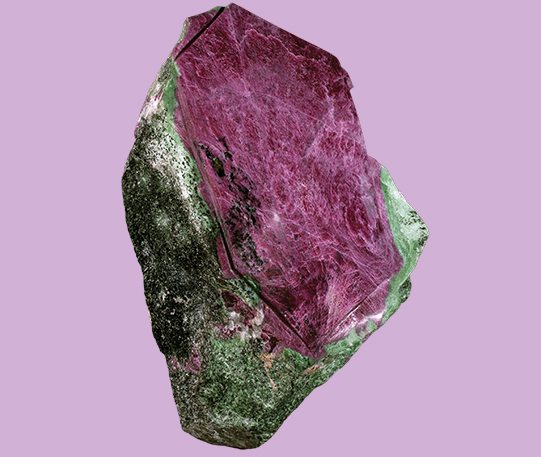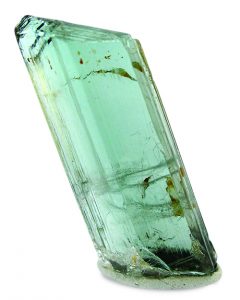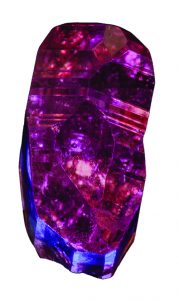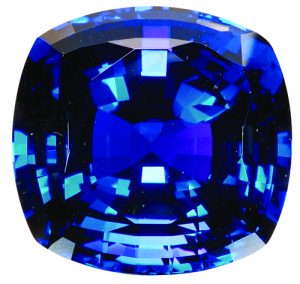
By Bob Jones
It is hard to believe zoisite is a massive mineral that makes lovely Christmas gems, appears in a cartoon, and is also one of the world’s more valuable gems.
I first encountered zoisite in the 1950s when I was already actively attending club meetings and visiting mineral shops. Later, for over two decades, I drove across the country each summer to work on my dad’s farm. Since I was able to stop at countless rock shops during these travels, I became well aware of a remarkable green and red lapidary rock in significant quantities. In those early days, it was described as a recent find from Africa and was immediately popular with lapidary artists and collectors, alike.
Discovering Zoisite
The massive green mineral was crystalline zoisite, which was slightly sugary looking. Locked in the green stone were hexagonal deep red crystals of ruby, which contrasted with the green host rock. The ruby crystals varied in size and were opaque to translucent in perfect hexagonal form.
The ruby crystal terminations were as much as four inches across. In some of the larger pieces, the exposed termination end of the ruby was slightly translucent, so when domed and polished, the stone showed a lovely chatoyant shimmer. There were no free-standing ruby crystals, but the lovely combination of red ruby and green zoisite in a single rock was attractive to lapidary artists, who soon recognized the red-green combination as an ideal Christmas theme.

A third mineral in the red-green rock was small black spots and crystalline rods, scattered throughout the green zoisite in stark contrast to the red and green colors. In the early days, the black mineral was initially labeled hornblende. Though I did not do lapidary work, I was curious enough to learn about the zoisite-ruby combination.
The discovery of zoisite-ruby rock happened in 1949 when an English prospector named Tom Blevins worked in Tanzania. While prospecting, he came across a deposit of large opaque ruby crystals. He immediately staked claims — in hopes he could make a fortune if some of the rubies proved to be gemmy and could be cut. However, luck was not on his side.
The zoisite deposit was part of a substantial regional metamorphic area composed mainly of schists and marble formations. Mining commenced on the deposit in hopes deeper mining would reveal gem crystals. That did not happen.
Fruitful Mining
However, mining of the deposit did prove fruitful — with the discovery of the red-green gemstone combination in 1954. Soon after the discovery, the material was marketed as excellent cutting rough. Before Blevins’ discovery, the local Maasai tribe was aware of the deposit and called it anyoli, which means “green stone.” Even now, you may come across that name on an older specimen of zoisite-ruby rock. Today, some 70 years after its discovery, the Tanganyika’s ruby-zoisite deposit is still the only major source for this lovely carving material. Kenya has produced some but in limited amounts.
As time has passed, not only has the name of the country where the zoisite-ruby combination was found changed, so too has the name of the black mineral often found in tandem with the green-red beauty.
Tanganyika, like so many African countries, was under colonial rule in the early 19th century. When Europeans took over the governing of Africa, the zoisite region of Tanganyika came under the control of the Germans as part of German East Africa. This rule lasted until Germany’s defeat during World War I — when the British took control and managed the area — until World War II came to an end. After that war, control of the region brought another name change when placed in the United Nations’ hands as a trust. Then, in 1964, the area that had been Tanganyika was merged with Zanzibar and became the United Republic of Tanganyika and Zanzibar. Later, the Zanzibar name was dropped. Today the primary zoisite-ruby source is the United Republic of Tanganyika.
Unique Presentation
While doing research for this article, I came across some surprising and, what I thought, quite fascinating non-mineral information involving mineral names used in odd ways. To rockhounds and scientists, zoisite is a mineral. In a popular Japanese cartoon adventure, which launched in the early 1990s, zoisite is also the name of a cartoon character. On the program, zoisite is joined by several other characters with mineral names. Broadcast worldwide, the Japanese anime series is called “Sailor Moon,” which is also the zoisite heroine’s name.
The storyline of the series is the usual battle between good and evil throughout the

Heritage Auctions
universe. In their fight for good, the leading characters (a group called Shitennov) begin as the Heavenly Zoisite, Jadeite, Kunzite, and Nephrite. Their main charge or responsibility, to guard Prince Endymion. However, in the process, the group members themselves transform into evil characters at times due to charges of negative energy from the Dark Side — and they end up becoming servants of Queen Beryl.
Other mineral names like hematite and silver crystal also crop up as characters. The anime television series was popular on a global level, earning millions of dollars. You can catch an episode in multiple places online — type in the name Sailor Moon. It is all quite fanciful and has absolutely nothing to do with minerals, but it is fun to see mineral names used in this creative way.
Be that as it may, beyond Japanese anime, zoisite occurs in many localities and has been found in various forms. When found crystallized, it can exhibit multiple colors. Zoisite is much more well-known for its lapidary uses in various massive carved material forms. It can be colorless, yellow, green, green, green-brown, pink, blue, and purple in both massive and crystallized form. The pink color is best known in massive form and is called thulite, and I’ll discuss more later in this article. Lapidary artists are more familiar with African green and pink material.
The crystal variety thus most valuable and exciting is seldom thought of as zoisite. It has striking colors for a type of zoisite, presenting as blue to violet in color. The mineral is known as tanzanite, a name for the country where tanzanite is found.
Tanzanite occurs in a metamorphic deposit in the Merelani Hills, near Arusha, which is in sight of Mount Kilimanjaro, Africa’s highest mountain — where tanzanite was found in 1967. Once found, it was brought to the U.S. by geologist Campbell R. Bridges, who later discovered the superb green garnet tsavorite.
History of Appeal
The new gem tanzanite, named by Tiffany & Co., took the gem world by storm. Crystals were found just over 50 years ago by a local prospector, and Bridges brought some of the first crystals to Tiffany’s in New York. The company immediately introduced the gem as something new and exceptional. Since that time, tanzanite has become one of the top gems in the marketplace for quality, beauty, and value. It rivals most rubies and sapphires and other gems. Only diamonds, which are far more common than tanzanite, can cost more due to a controlled market. Diamonds are nowhere near as beautiful as tanzanite, in my humble opinion. Only the rare and unusual blue sapphires and deep blood red rubies command higher prices than tanzanite.
The initial tanzanite crystals showed the lovely blue to the violet color we all recognize. As mining continued at depth, fewer blue crystals were found and the crystals being mined had to be heat treated to remove an unwanted brownish hue. The treatment is permanent and brings out the classic blue color.
What I find most interesting is tanzanite’s natural trichroism, three different colors in the same natural crystal. Look at a natural crystal through its main prism face and you’ll see one color. Turn it 90 degrees and you’ll see the second color. Look down the crystal’s vertical axis to see the third color: violet, blue and red, respectively. Note each of the three colors I referred to is permanent in a natural crystal. Just about all tanzanite mined today has to be heat-treated, but the result is the gorgeous blue-violet desired color. This treatment disturbs the trichroism, but the result is a permanent blue to violet hue. Look back at the October 2019 issue of Rock & Gem to enjoy a more detailed article, which I wrote, about tanzanite.
Gem collectors seldom realize their lovely blue tanzanite gem or crystal is related to the red-green ruby zoisite rock. There is also another massive variety of zoisite we seldom hear much about today, which is thulite. Thulite is sometimes called rosaline for its pink color. Its site locality is an island off Norway.

MINERAL TRUST GEM
Thulite has also been found in Austria, in small crystals. But the initial find was a material sought after by lapidary artists, a translucent pink solid rock suitable for carving and cabochons. It was found in Sauland, off Norway, in 1820 and named after Thule, the Island of Lore and Stories. Pink thulite is a popular material for cabochons, although it does need to be protected when mounted, as it has a hardness between two and three on the Moh’s scale. It is compact, slightly granular, and is usually spotted white by included calcite, and the shades of pink are undoubtedly due to manganese substituting for calcium.
As I remarked at the beginning of this article, ruby-zoisite material provides carvers and lapidary artists with opportunities to create spectacular Christmastime art. The only problem with ruby-zoisite is the random occurring of spots and needles of the black mineral hornblende, and slight undercutting has to be compensated.
Call the red and green rock what you wish — the lovely contrasting red and green colors in the material given to us by nature is very well suited for the holiday season and creating stunning and memorable gifts.












